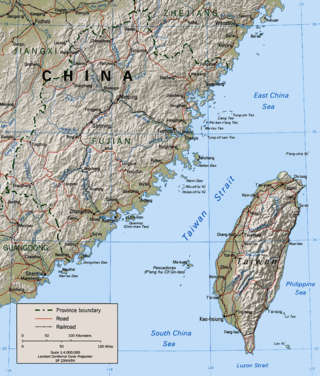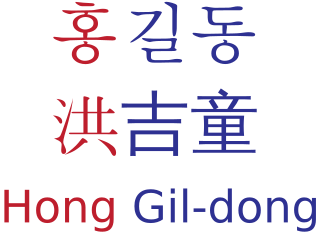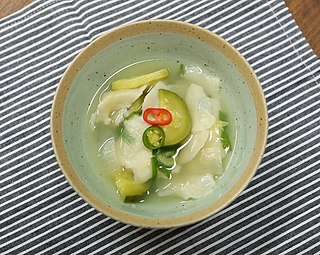
Korean is the native language for about 81 million people, mostly of Korean descent. It is the official and national language of both North Korea and South Korea. The language has notable differences in each of the Koreas, in part owing to different official standardizations of the language. They are still largely mutually intelligible, however. South Korean newspaper Daily NK has claimed North Korea criminalizes the use of the South's standard language with the death penalty, and South Korean education and media often portray the North's language as alien and uncomfortable.

Wade–Giles is a romanization system for Mandarin Chinese. It developed from a system produced by Thomas Francis Wade, during the mid-19th century, and was given completed form with Herbert A. Giles's Chinese–English Dictionary of 1892.

Hanja, alternatively known as Hancha, are Chinese characters used in the writing of Korean. Hanja was used as early as the Gojoseon period under the first Korean kingdom.

A Korean name in the modern era typically consists of a surname followed by a given name, with no middle names. A number of Korean terms for names exist. For full names, seongmyeong, seongham, or ireum (이름) are commonly used. When a Korean name is written in Hangul, there is no space between the surname and the given name.

A breve is the diacritic mark ◌̆, shaped like the bottom half of a circle. As used in Ancient Greek, it is also called brachy, βραχύ. It resembles the caron but is rounded, in contrast to the angular tip of the caron. In many forms of Latin, ◌̆ is used for a shorter, softer variant of a vowel, such as "Ĭ", where the sound is nearly identical to the English /i/.

In linguistics, romanization is the conversion of text from a different writing system to the Roman (Latin) script, or a system for doing so. Methods of romanization include transliteration, for representing written text, and transcription, for representing the spoken word, and combinations of both. Transcription methods can be subdivided into phonemic transcription, which records the phonemes or units of semantic meaning in speech, and more strict phonetic transcription, which records speech sounds with precision.

McCune–Reischauer romanization is one of the two most widely used Korean-language romanization systems. It was created in 1937 and the ALA-LC variant based on it is currently used for standard romanization library catalogs in North America.
The following tables of consonants and vowels (jamo) of the Korean alphabet (Hangul) display the basic forms in the first row and their derivatives in the following row(s). They are divided into initials, vowels (middle), and finals tables.

Revised Romanization of Korean is the official Korean language romanization system in South Korea. It was developed by the National Academy of the Korean Language from 1995 and was released to the public on 7 July 2000 by South Korea's Ministry of Culture and Tourism in Proclamation No. 2000-8.

The writing system of the Korean language is a syllabic alphabet of character parts organized into character blocks representing syllables. The character parts cannot be written from left to right on the computer, as in many Western languages. Every possible syllable in Korean would have to be rendered as syllable blocks by a font, or each character part would have to be encoded separately. Unicode has both options; the character parts ㅎ (h) and ㅏ (a), and the combined syllable 하 (ha), are encoded.
.kr is the Internet country code top-level domain (ccTLD) for the Republic of Korea. Registrations are processed via registration agents.

The Phagspa script or ʼPhags-pa script is an alphabet designed by the Tibetan monk and State Preceptor Drogön Chögyal Phagpa (1235-1280) for Kublai Khan, the founder of the Yuan dynasty (1271-1368) in China, as a unified script for the written languages within the Yuan. The actual use of this script was limited to about a hundred years during the Mongol-led Yuan dynasty, and it fell out of use with the advent of the Ming dynasty.

SKATS stands for Standard Korean Alphabet Transliteration System. It is also known as Korean Morse equivalents. Despite the name, SKATS is not a true transliteration system. SKATS maps the Hangul characters through Korean Morse code to the same codes in Morse code and back to their equivalents in the Latin script. Any phonetic correspondence between the Korean and Roman letters would be purely coincidental.
The won is the currency of both North and South Korea. "Won" is a cognate of the Chinese currency unit, the yuan, and the Japanese currency unit, the yen, meaning "round object". The won is subdivided into 100 jeon.

The Kontsevich system is a Cyrillization system for the Korean language and currently the main system of transcribing and transliterating Korean words into the Cyrillic alphabet. The Kontsevich system was created by the Soviet-Russian scholar Lev Kontsevich in the 1950s based on the earlier transliteration system designed by Aleksandr Kholodovich.

Korean mixed script is a form of writing the Korean language that uses a mixture of the Korean alphabet or hangul and hanja, the Korean name for Chinese characters. The distribution on how to write words usually follows that all native Korean words, including suffixes, particles, and honorific markers are generally written in hangul and never in hanja. Sino-Korean vocabulary or hanja-eo, either words borrowed from Chinese or created from Sino-Korean roots, were generally always written in hanja, although very rare or complex characters were often substituted with hangul. Although the Korean alphabet was introduced and taught to people beginning in 1446, most literature until the early twentieth century was written in literary Chinese known as hanmun.

Sujebi, ttŭdŏ-guk, or hand-pulled dough soup, or Korean-style pasta soup, is a Korean traditional soup consisting of dough flakes roughly torn by hand, with various vegetables. The flavor and recipe resemble kalguksu, except that the latter is made with noodles rather than wheat flakes. It is commonly considered a dish to consume on rainy days, along with bindaetteok.

The Yale romanization of Korean was developed by Samuel Elmo Martin and his colleagues at Yale University about half a decade after McCune–Reischauer. It is the standard romanization of the Korean language in linguistics.

The Korean alphabet, known as Hangul in South Korea and Chosŏn'gŭl in North Korea, is the modern official writing system for the Korean language. The letters for the five basic consonants reflect the shape of the speech organs used to pronounce them, and they are systematically modified to indicate phonetic features; similarly, the vowel letters are systematically modified for related sounds, making Hangul a featural writing system. It has been described as a syllabic alphabet as it combines the features of alphabetic and syllabic writing systems.












